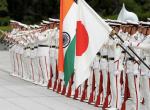Introduction
Eighty years after the March 1945 bombing of Tokyo that killed around 100,000 people, Japan remains divided on whether to uphold its pacifist stance or play a more pro-active role in regional security. The most significant shift lies in Japan’s recent decision to ease arms export restrictions—marking a bold departure from its post-war pacifist policy.
Despite Article 9 of Japan’s Constitution, which renounced war, Japan was never entirely barred from arms exports. However, exports were strongly discouraged. In 1967, Tokyo imposed the Three Principles on Arms Exports to restrict sales to communist bloc nations, countries under embargoes, and those involved in conflicts. By 1976, these were broadened, virtually halting arms exports altogether.
Initial relaxations came in 2011 under Prime Minister Yoshihiko Noda, allowing limited exports for joint development programmes. Substantial changes arrived in April 2014 under Prime Minister Shinzo Abe, aligning with the 2013 National Security Strategy. The Three Transfer of Technology Principles allowed arms transfers that contributed to global peace and Japan’s security, with tight controls to prevent unauthorised use.
In December 2023, Japan amended export controls further, allowing domestically produced defence platforms—including lethal weapons—to be exported to countries that hold production licences. This was reaffirmed in February 2025 when Prime Minister Shigeru Ishiba met U.S. President Donald Trump and agreed to further enhance Japan’s defence capabilities by 2027 and beyond. This aligns with Washington’s push for allies to share more of the defence burden.
Shifting Security Dynamics
A primary driver of this shift is concern over China’s strategic expansion. Beijing has historically exploited regional power vacuums—occupying the half of Paracel Islands after France’s 1950s withdrawal, seizing another half in 1974 after the U.S. exited South Vietnam, and expanding in the Spratly Islands in 1988 following the Soviet military drawdown in Vietnam. In 1995, China took over Mischief Reef shortly after the U.S. left the Philippines. These patterns suggest China takes advantage of military imbalances to extend its reach.
Japan views waning U.S. deterrence as fuelling China’s growing assertiveness. According to the Stockholm International Peace Research Institute between 2014 and 2023, China boosted military spending by 60%, compared to the U.S.’s 9.9%. Though the U.S. still spends three times more than China, the regional balance appears to be shifting, prompting the U.S. to call for greater burden-sharing.
Japan’s Strategic Role in the Indo-Pacific
Japan’s arms exports aim to rebalance regional power, act as a force multiplier for the U.S., and empower Indo-Pacific nations to avoid becoming vulnerable to Chinese expansion.
Two key factors support Japan’s expanding defence role. First, many Indo-Pacific nations previously relied on Russian arms, but the Russia-Ukraine war disrupted supply chains, pushing them to find alternatives. Japan’s growing defence industry is an attractive option, especially for countries wary of dependence on Western suppliers. Second, China’s assertive claims in the South China Sea have alarmed regional neighbours. Japan’s military exports—such as maritime surveillance equipment and coastal defence systems—offer a deterrent to countries like the Philippines, Indonesia, Malaysia, and Vietnam. Defence exports also build long-term ties, as weapons require maintenance, parts, and training.
To support this strategy, Japan signed a Reciprocal Access Agreement with the Philippines in 2022, allowing joint training and equipment exchanges. In 2023, Japan delivered a $103 million FPS-3ME radar system to the Philippine Air Force, boosting maritime security from Wallace Air Station on Luzon. In February 2025, both countries signed a high-level agreement to deepen defence ties amid tensions over Second Thomas Shoal and Sabina Shoal, where recent maritime clashes with China have occurred.
Japan has also deepened defence ties with India. In 2024, it exported its first defence technology—the Unified Complex Radio Antenna (UNICORN) for naval ships—and plans are underway for co-development. This marked a milestone in Japan–India security cooperation.
Although Australia eventually opted for the AUKUS submarine pact, Japan had earlier pitched its Sōryū-class submarines. Still, Japan and Australia have strengthened ties under a Joint Declaration on Security Cooperation. Tokyo has also proposed its Mogami-class frigates for Australia’s warship programme.
Taiwan and Regional Considerations
Taiwan remains a critical security concern. Japan has enhanced indirect cooperation with Taiwan in areas like missile detection and submarine technology—reportedly involving retired Japanese engineers. As cross-strait tensions escalate, further support to Taiwan could follow. Japan is also in talks to supply eight Mogami-class frigates to Indonesia and Kawasaki P-1 maritime patrol aircraft to Thailand and Vietnam.
Beyond hardware, Japan has pledged $25 billion in security aid to ASEAN nations over the next decade, covering equipment, cybersecurity, and capacity-building.
Challenges and Domestic Considerations
Yet Japan’s policy faces significant challenges. A 2023 Mainichi Shimbun poll showed 48% of citizens oppose arms exports, revealing strong pacifist sentiment. Even Komeito, the Liberal Democratic Party’s coalition partner, approved the recent changes only reluctantly. Defence firms are also wary—just 10% of their revenue comes from defence contracts, and over 100 companies leaving the sector in the past 20 years due to reputational risks.
Geopolitically, China accuses Japan of violating its pacifist principles and fuelling an arms race. Beijing sees the move as part of a U.S.-led containment strategy. North Korea has also condemned the exports, using them to justify further missile and nuclear development.
Conclusion
Still, Japan’s decision marks a strategic recalibration in Indo-Pacific security. While controversial, it aligns with multilateral initiatives like the Quad, which aim to ensure a free and open Indo-Pacific.
With rising regional threats, countries must acquire arms to deter aggression. Japan’s regulated arms exports provide an alternative to reliance on external suppliers, while fostering regional interoperability and maintaining a rules-based order.
Nevertheless, this is a double-edged sword. Japan must carefully balance its pacifist roots with its strategic ambitions. How it manages this transition will shape its role in Indo-Pacific security for decades to come.
(The paper is the author’s individual scholastic articulation. The author certifies that the article/paper is original in content, unpublished and it has not been submitted for publication/web upload elsewhere, and that the facts and figures quoted are duly referenced, as needed, and are believed to be correct). (The paper does not necessarily represent the organisational stance... More >>
Image Source: https://akm-img-a-in.tosshub.com/businesstoday/images/story/202012/india_japan_660_091220124847.jpg?size=948:533










Post new comment